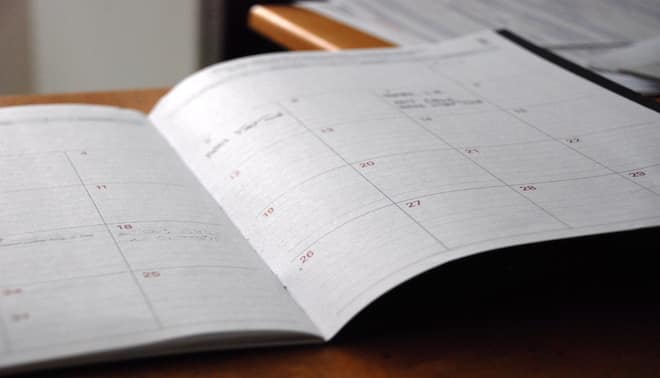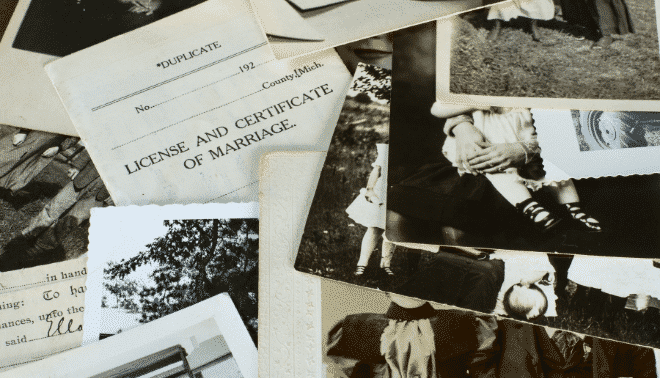Sign up for the Family Tree Newsletter! Plus, you’ll receive our 10 Essential Genealogy Research Forms PDF as a special thank you.
Get Your Free Genealogy Forms
"*" indicates required fields

A research plan helps you record the who, what, when, where and why of your family history quest. Think of it as a road map, or in modern terms, a GPS that provides a navigational system to your past. Just as you wouldn’t attempt to change the oil in your car without instructions or try to prepare a baked Alaska without a recipe, you shouldn’t even think about going on your ancestral journey without a solid plan.
In this article, I’ll take you through a simple, five-point strategy to create a research plan by showing you how I used this method to trace the birth, marriage and death records of my paternal great-grandfather, Mihaly Fenscak. You can use it as a model to chart your own course for genealogical success.
1. Establish a Genealogy Research Objective
Write down as specifically as possible what you want to accomplish. Perhaps you want to identify the name of the overseas town or village where your great-grandfather was born, or when he immigrated to the United States.
Your objective should include both long-term research goals and the short-term steps that will help you reach your overall objective (note any steps you can think of now, but you’ll add more as you develop your plan). For example, a long-term goal might be to determine when your great-grandfather left home and the date he arrived in the United States. A short-term goal might be to locate him in a US federal census that asks for the year of immigration—the 1900, 1910, 1920 and 1930 censuses.
Like most family historians, you probably have more than one genealogy problem you’re trying to solve. For now, though, choose one or two to focus on. My objective was to find the birth, marriage and death dates for my great-grandfather.
2. List Known Ancestor Facts
Assuming you’ve completed a pedigree chart and family group sheet using genealogy software or one of our free forms, your next step is to list known facts about the person you’re researching.
You can use the free, downloadable biographical outline form here to record your known facts. Examine any genealogical records you’ve gathered and write down what they tell you. Include names of the person and his family members; any spelling variations of the first and last names you’ve found in records; dates of birth, death and marriage; dates of migrations; and places where his life events took place.
For example, you may know your great-grandfather had three sisters and two brothers, and you may even have their first names from a family Bible or other book. Perhaps you have a marriage date or location, or a record that refers to a particular county seat or region in the old country. Think of these facts as your data points that you’ll plug into your genealogy GPS.
One caveat: Be careful not to blindly accept as truth family tales about where your ancestors went and why. You can treat these as clues and investigate their validity by tracking down records to document what happened.
I looked in home and family sources and wrote some notes I made during my search. I was able to determine the following from a family narrative naming Mihaly Fenscak and his wife, Illa. Other clues included:
- Ancestral village listed as Posa, Slovakia.
- Also mentioned time spent in Liverpool, England, and Freeland, Pa.
- Mihaly was a widower with two children, Anna and John, when he married Illa.
- His children with Illa were: Mary, born in Liverpool; Anna, born in Freeland; Elizabeth and Mihaly (Mike) Fenchak, both born in Slovakia.
- Mihaly died first and Illa remarried a man named Zelenak—no date listed but story notes that she died before World War I because her daughter, who was already in America, returned to Slovakia to care for her mother and was unable to return to America because of the war.
From this narrative I was able to pinpoint some information to research:
- Surnames and variations: Fenscak/Fencak/Fenchak/Finch, Alzo, Bavolar, Ceyba, Ragan and Zelenak.
- First names and variations (Hungarian/Slovak/English): Mihaly/Michael/Mike, Illa/Ilona/Helen, Erzebet/Elizabeth, Jan/Janos/Jan, Mary and Anna.
3. Form a Working Hypothesis
Based on the known facts you recorded in the previous step, make some educated guesses about the possible answers to your research question or problem. For example, say you know your great-grandfather’s date of birth and that he was born in Germany, but his sister who was five years younger was born in America. That lets you estimate a date range—between the two birth dates—for their family’s immigration to the United States. If you’ve found their father in the 1900 census and then again in the 1920 census, but not in 1910, you could speculate that he moved. Or perhaps he was a “bird of passage” who came to the United States for a short time, worked to earn enough money to return home and buy land, and then came back to America later.
Here’s the hypothesis I came up with, outlining Mihlay Fenscak’s life.
Mihaly Fenscak was born in Posa, Slovakia, married there and had two children. His first wife died and then he married Illa. Their first child was born in Liverpool, England, and then they arrived in America. While in Freeland, Pa., their daughter Anna was born, and then they eventually returned to Slovakia where their final two children, Elizabeth and Michael, were born. Mihaly and Illa both died in Slovakia. Their three daughters eventually settled in America, and their son in Argentina. Mihaly’s children from first wife: John settled in America, and Anna stayed in Slovakia and married.
4. Identify Sources with Related Records
Now it’s time for some searching: Become familiar with the types of records most likely to prove (or disprove) your hypothesis. Include both primary sources (those created at or near the time of an event, usually by a direct observer) and secondary sources (those created either much later than the event, or by someone who was reading or interpreting a primary source). Primary sources are generally preferable to secondary sources because they’re more likely to be accurate.
Note that the same source might be a primary source of some information, and a secondary source of other information. For example, a death certificate is a primary source of the cause of death, but a secondary source of the deceased’s date of birth (reported years after the birth by someone probably lacking first-hand knowledge).
TIP: For more information on evaluating primary and secondary sources, see the question under “Evidence Analysis” as part of the Board for Certification of Genealogists FAQ page.
Among the records that would provide your great-grandfather’s US arrival date are passenger lists, naturalization records and maybe Alien Registration files (created from 1940 to 1944 when the US government required non-citizens to register as aliens). Do some research to find out what records are available for the time period you’re researching, where they’re located (such as your public library or the National Archives) and in what format (microfilm, digitized online, indexed in a book, etc.).
Once I established my hypothesis, I listed records and other sources I felt would be useful based on what I learned in step 2:
- Family narrative (original source)
- 1910, 1920 and 1930 US Census records for Elizabeth Fenchak Alzo, Mary Fenchak Ceyba, Anna Fenchak Bavolar and John Fenchak
- Death certificates for Elizabeth Fenchak Alzo, her sisters Anna and Mary, and her brother John
- Ellis Island database for Port of New York passenger lists
- Other passenger lists for other ports as needed
- Port of departure lists (emigration) for Hamburg, Germany, and Bremen, Germany (as available)
- Cemetery tombstones in Duquesne, Pa.
- Marriage records for Elizabeth and siblings in the United States
- Naturalization papers/declaration of intent for Elizabeth, Anna, Mary and John
- Search Social Security Death Index for all children of Mihaly Fenchak who settled in America. Write for SS-5 Applications.
- FamilySearch Library (FSL) microfilm of births, marriages and deaths in Posa, Slovakia, and 1869 Hungarian census returns for Zemplen County, Hungary
5. Define Steps for Accessing and Using Resources
Next, determine how you’ll access those records. Can you find them on a subscription website such as Ancestry.com? (And is free access to the site available at your local public library or FamilySearch center)? In researching your great-grandfather’s immigration, for example, you’ll find digitized naturalization records for many areas of the United States, and Ancestry.com has nearly all extant passenger lists for US ports and borders. The free website EllisIsland.org has information on passengers arriving at the Port of New York.
If you can’t find the records online, you may need to order microfilm through a FamilySearch center, submit an interlibrary loan request or order the records from a repository, such as the National Archives.
Once you know how to access the records, determine the order in which you’ll seek them. For example, you might decide it’s easiest to first check the passenger lists and naturalization indexes in Ancestry.com’s online immigration databases, then visit your library for printed resources such as Germans to America: Lists of Passengers Arriving at US Ports 1850-1897 by Ira A. Glazier and P. William Filby (Scarecrow Press), and go to your FamilySearch center to rent microfilmed naturalization records that you’re unable to find online.
TIP: To help you research record sources, type the record you want to find out about into the FamilySearch Research Wiki search box. In your search results, click a matching article title for how-to information on the topic.
To avoid repeating the same fruitless searches on the same websites again and again, keep a written record of all the sources you search, the date you search them and what you find (or don’t find). You may be able to do this in your genealogy software, or use this free, downloadable Research Journal. When one resource points to another type of record you should check, note that in your research journal, too.
Once I had a list of records and other sources for information on Mihaly, I came up with research strategies for each one:
- Check online US Census records (1910, 1920, 1930) for children of Mihaly and Illa Fenchak.
- Confirm naturalizations and confirm place of birth (1920, 1930 census); locate certificates and declarations of intent either in Pennsylvania or at the federal level using Freedom of Information Act request form.
- Search the online Ellis Island database and Ancestry.com Immigration & Travel Collection for Anna, Mary, John and Elizabeth; also for Mihaly and Illa Fenchak.
- Search Social Security Death Index for all children of Mihaly Fenchak who settled in America; If found, request SS-5 Applications from the Social Security Administration.
- Check cemeteries in Duquesne, Pa., for tombstones and write for death records for Anna Bavolar, Mary Ceyba and John Fenchak.
- Contact or visit appropriate courthouses in Allegheny County, Pa., for marriage records.
- Find birth records for Anna (Pennsylvania), Mary (Liverpool, England) and Elizabeth, Michael and John (Slovakia).
- Search the FSL catalog for records available for Posa, Slovakia, to view online or at a FamilySearch location. Relevant records include church records for Posa (microfilm film numbers: 1793237, 1793238 and 1793239) and the 1869 Hungarian Census for Zemplen county (film number 722769). Search films for all listings of the name “Fenscak.”
It may seem overwhelming at first, but don’t let making research plans intimidate you. A little practice and it will become easier and easier to make plans and identify hypotheses. Remember, a solid research plan is key to making ancestral breakthroughs and knocking down those brick walls standing between you and your ancestors.

Download your free Research Planner and Log from Family Tree Magazine!
Related Reads
A version of this article appeared in the January 2011 issue of Family Tree Magazine. Last updated: May 2025








